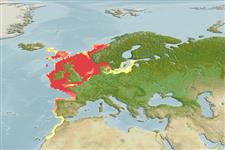>
Gadiformes (Cods) >
Gadidae (Cods and haddocks)
Etymology: Trisopterus: Greek, tris = thrice + Greek, pteron = wing, fin (Ref. 45335).
More on author: Linnaeus.
Issue
The species has been long thought to be present in the Mediteranean in sympatry with Trisopterus capelanus, sometimes both as subspecies. See Delling et al. (2011: Ref. 90172) for the latest revision of the genus.
Environment: milieu / climate zone / depth range / distribution range
Ecología
marino bentopelágico; no migratorio; rango de profundidad 1 - 440 m (Ref. 57178), usually 15 - 200 m. Temperate; 66°N - 28°N, 13°W - 36°E
Northeastern Atlantic: Trondheim Fjord and the Faeroe Islands to Portugal and along the Atlantic coast of Morocco (Ref. 1371). Not present in the Mediterranean (Ref. 90172).
Length at first maturity / Tamaño / Peso / Age
Maturity: Lm 13.3, range 10 - 26 cm
Max length : 40.0 cm TL macho / no sexado; (Ref. 1371); common length : 20.0 cm TL macho / no sexado; (Ref. 4645); edad máxima reportada: 5 años (Ref. 72488)
Espinas dorsales (total) : 0; Espinas anales: 0. Chin barbel well developed. Body brownish yellow dorsally, becoming paler ventrally; a dark blotch is at the base of the pectoral fin.
Occurs mostly from 15 to 200 m in the Atlantic on muddy or sandy bottoms. Feeds on crustaceans, small fish, and polychaetes (Ref. 1371). Used in the production of fish meal, and in southern Europe as a human food (Ref. 35388).
Oviparous, sexes are separate (Ref. 205).
Cohen, D.M., T. Inada, T. Iwamoto and N. Scialabba, 1990. FAO species catalogue. Vol. 10. Gadiform fishes of the world (Order Gadiformes). An annotated and illustrated catalogue of cods, hakes, grenadiers and other gadiform fishes known to date. FAO Fish. Synop. 125(10). Rome: FAO. 442 p. (Ref. 1371)
IUCN Red List Status (Ref. 130435)
Threat to humans
Harmless
Human uses
Pesquerías: comercial
Herramientas
Special reports
Download XML
Fuentes de Internet
Estimates based on models
Preferred temperature (Ref.
123201): 7.2 - 13, mean 10 °C (based on 1312 cells).
Phylogenetic diversity index (Ref.
82804): PD
50 = 0.5625 [Uniqueness, from 0.5 = low to 2.0 = high].
Bayesian length-weight: a=0.00741 (0.00662 - 0.00830), b=3.11 (3.08 - 3.14), in cm total length, based on LWR estimates for this species (Ref.
93245).
Nivel trófico (Ref.
69278): 3.7 ±0.2 se; based on diet studies.
Generation time: 2.7 (2.2 - 4.2) years. Estimated as median ln(3)/K based on 10
growth studies.
Resiliencia (Ref.
120179): Medio, población duplicada en un tiempo mínimo de 1.4-4.4 años (K=0.18; tm=1; tmax=6).
Prior r = 0.54, 95% CL = 0.35 - 0.81, Based on 2 full stock assessments.
Fishing Vulnerability (Ref.
59153): Moderate vulnerability (37 of 100).
Climate Vulnerability (Ref.
125649): Low vulnerability (7 of 100).
Nutrients (Ref.
124155): Calcium = 66.1 [16.9, 219.6] mg/100g; Iron = 0.674 [0.145, 2.965] mg/100g; Protein = 18.3 [15.8, 20.4] %; Omega3 = 0.701 [0.351, 1.389] g/100g; Selenium = 19.3 [9.3, 38.8] μg/100g; VitaminA = 16.6 [3.8, 72.1] μg/100g; Zinc = 1.13 [0.27, 3.13] mg/100g (wet weight); based on
nutrient studies.
